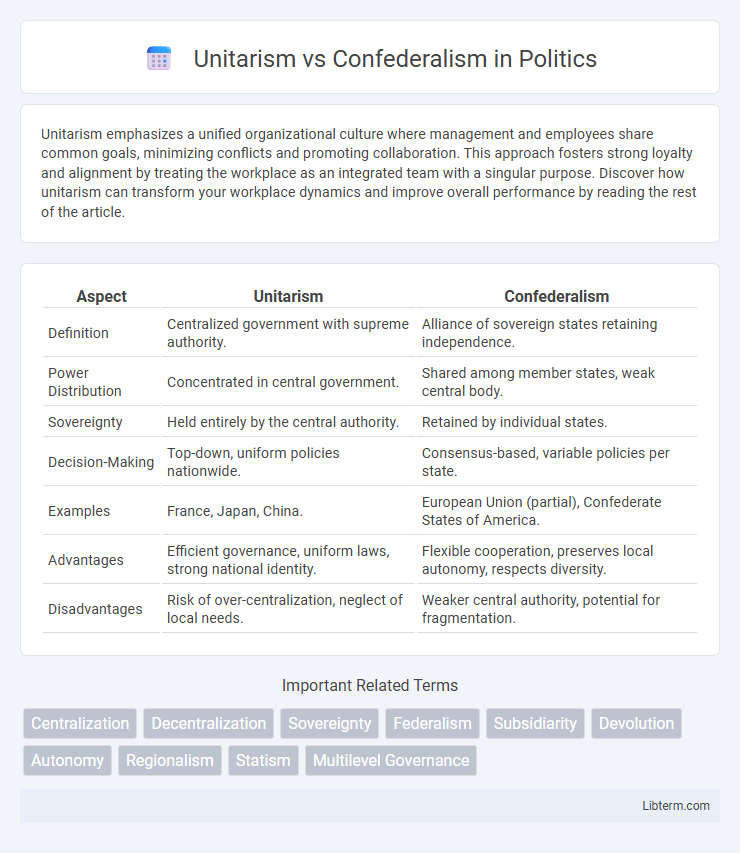Unitarism emphasizes a unified organizational culture where management and employees share common goals, minimizing conflicts and promoting collaboration. This approach fosters strong loyalty and alignment by treating the workplace as an integrated team with a singular purpose. Discover how unitarism can transform your workplace dynamics and improve overall performance by reading the rest of the article.
Table of Comparison
| Aspect | Unitarism | Confederalism |
|---|---|---|
| Definition | Centralized government with supreme authority. | Alliance of sovereign states retaining independence. |
| Power Distribution | Concentrated in central government. | Shared among member states, weak central body. |
| Sovereignty | Held entirely by the central authority. | Retained by individual states. |
| Decision-Making | Top-down, uniform policies nationwide. | Consensus-based, variable policies per state. |
| Examples | France, Japan, China. | European Union (partial), Confederate States of America. |
| Advantages | Efficient governance, uniform laws, strong national identity. | Flexible cooperation, preserves local autonomy, respects diversity. |
| Disadvantages | Risk of over-centralization, neglect of local needs. | Weaker central authority, potential for fragmentation. |
Understanding Unitarism: Definition and Key Features
Unitarism is a political system characterized by a single, centralized government that holds supreme authority over all administrative divisions. Key features include uniform laws and policies across the entire territory, minimal regional autonomy, and centralized decision-making processes. This system contrasts sharply with confederalism, where power is distributed among semi-autonomous states or regions, emphasizing local governance.
Defining Confederalism: Principles and Structure
Confederalism is a political system characterized by a league of sovereign states that delegate limited powers to a central authority while retaining primary control over their own affairs. Its principles emphasize decentralized governance, autonomy of member states, and voluntary cooperation based on mutual agreement. The structure typically includes a weak central government with authority derived from the constituent states, ensuring that decisions often require consensus, preserving state sovereignty.
Historical Evolution of Unitarism and Confederalism
Unitarism and confederalism evolved from distinct historical contexts, with unitarism emerging as a reaction to fragmented feudal systems in early modern Europe, emphasizing centralized state authority to ensure political stability and uniform governance. Confederalism originated from loose alliances among sovereign states, exemplified by the Articles of Confederation in the United States and the Swiss Confederation, where member states retained significant independence while cooperating on common interests. Over time, unitarism influenced the formation of nation-states with centralized administrations, whereas confederalism persisted in regions valuing state sovereignty and decentralized power arrangements.
Centralization vs Decentralization of Power
Unitarism emphasizes the centralization of power within a single, sovereign authority, ensuring uniform policies and governance across the entire state. Confederalism advocates for decentralization, granting constituent units significant autonomy and decision-making powers to preserve local interests and prevent dominance by a central government. The balance between centralized control in unitarism and distributed authority in confederalism shapes the political and administrative structure of nations.
Political Representation and Decision-Making
Unitarism centralizes political representation and decision-making authority within a single, sovereign government, ensuring uniform policies across all regions. Confederalism distributes power among member states or regions, allowing localized political representation and collective decision-making through a confederate assembly or council. This decentralized structure in confederalism fosters regional autonomy but may complicate cohesive national governance.
Fiscal Autonomy in Unitary and Confederal Systems
Unitary systems centralize fiscal autonomy, with the national government controlling taxation and budget allocations to ensure uniform policy implementation. Confederal systems grant substantial fiscal autonomy to member states, allowing them to independently raise revenues and manage expenditures to maintain regional sovereignty. This fiscal distribution impacts resource allocation efficiency, accountability, and the balance of power between central and regional authorities.
Pros and Cons of Unitarism
Unitarism centralizes political power, offering benefits such as streamlined decision-making, uniform policies, and stronger national unity, which can enhance effective governance. However, its drawbacks include the risk of authoritarianism, diminished regional autonomy, and potential neglect of local needs and diversity. This system may struggle to accommodate cultural or regional differences, leading to dissatisfaction and potential conflict in heterogeneous societies.
Advantages and Disadvantages of Confederalism
Confederalism offers advantages such as greater regional autonomy, allowing member states to maintain sovereignty while cooperating on common interests like defense and trade. This system fosters flexibility and local decision-making, which can enhance cultural and political diversity. However, disadvantages include potential inefficiency due to weak central authority, difficulties in enforcing collective decisions, and risks of fragmentation or conflicts among member states.
Case Studies: Examples of Unitary and Confederal States
France exemplifies unitarism with centralized government authority ensuring uniform policies across its regions, while Switzerland represents confederalism through significant autonomy granted to its cantons, reflecting diverse local governance. Nigeria's federal system shows elements of unitarism with strong central control, contrasting with the confederal nature of the European Union where member states retain sovereignty and collaborate on specific issues. These cases highlight how unitary states prioritize centralized decision-making, whereas confederal states emphasize regional independence and cooperation.
Unitarism vs Confederalism: Which System Is More Effective?
Unitarism centralizes political power within a single national government, streamlining decision-making and ensuring uniform policies, which often enhances administrative efficiency and national unity. Confederalism, by contrast, allocates sovereignty primarily to constituent states or regions, allowing for diverse local governance but potentially causing coordination challenges and slower policy implementation. Effectiveness depends on context; unitarism suits homogenous societies needing cohesive control, while confederalism benefits diverse entities seeking autonomy and flexible power distribution.
Unitarism Infographic

 libterm.com
libterm.com